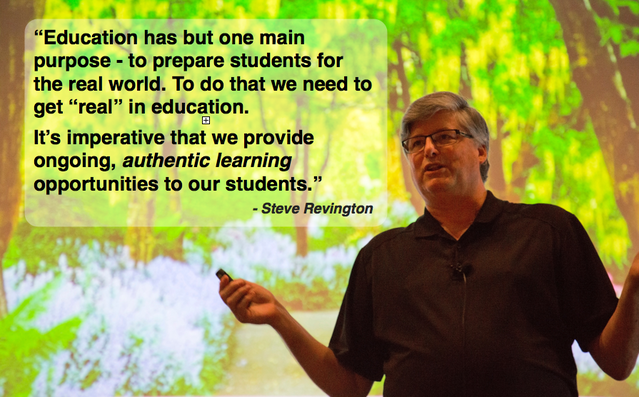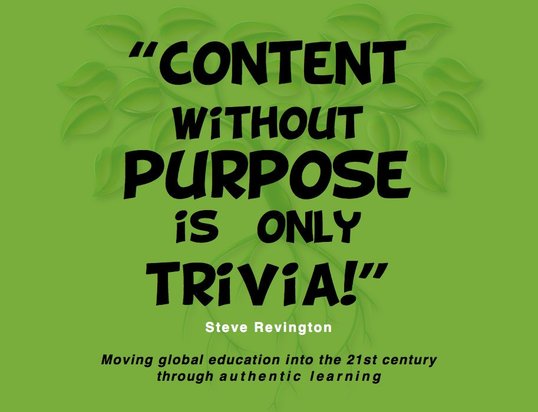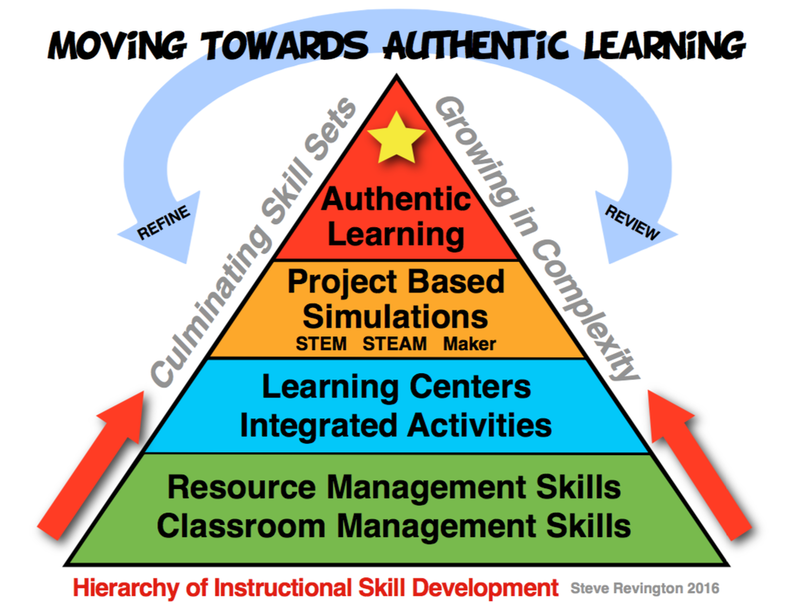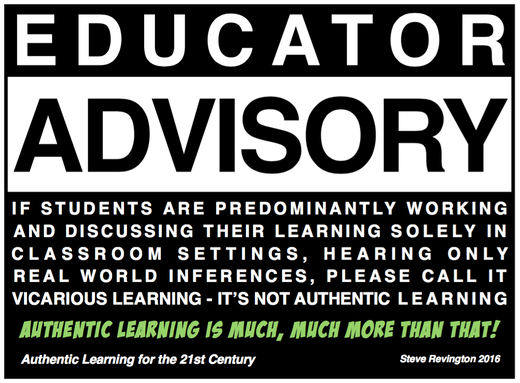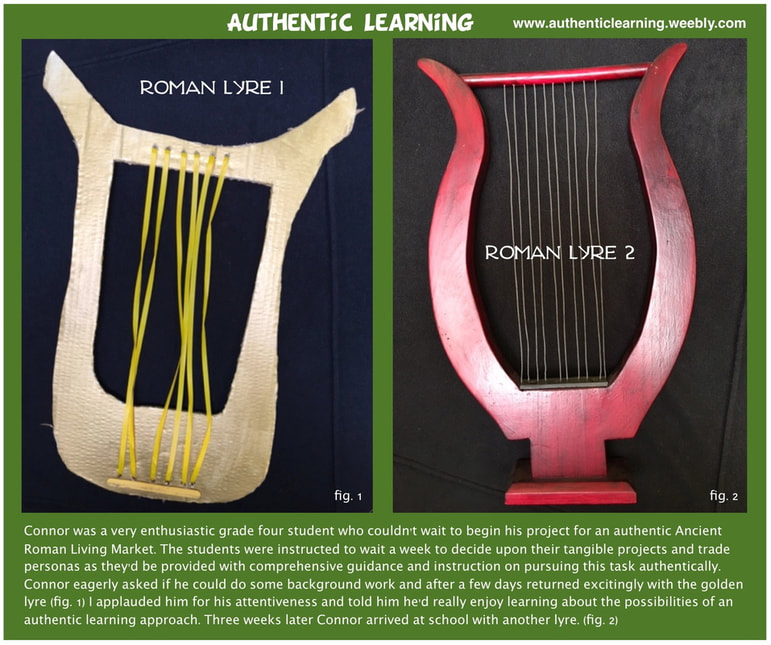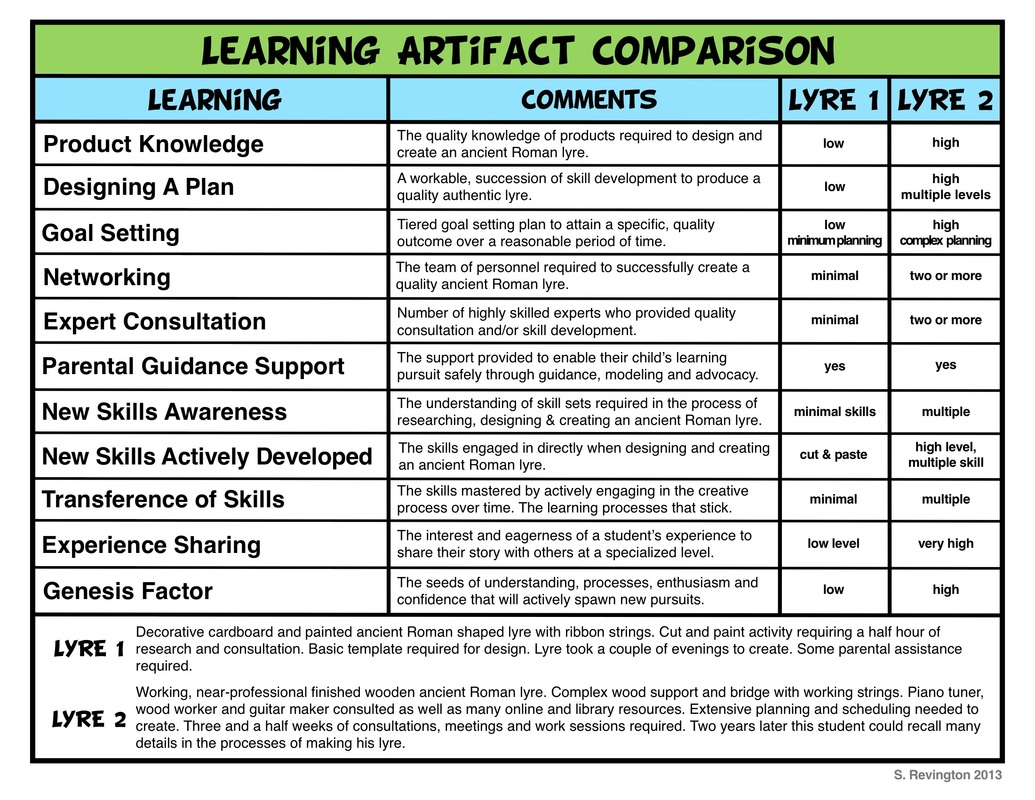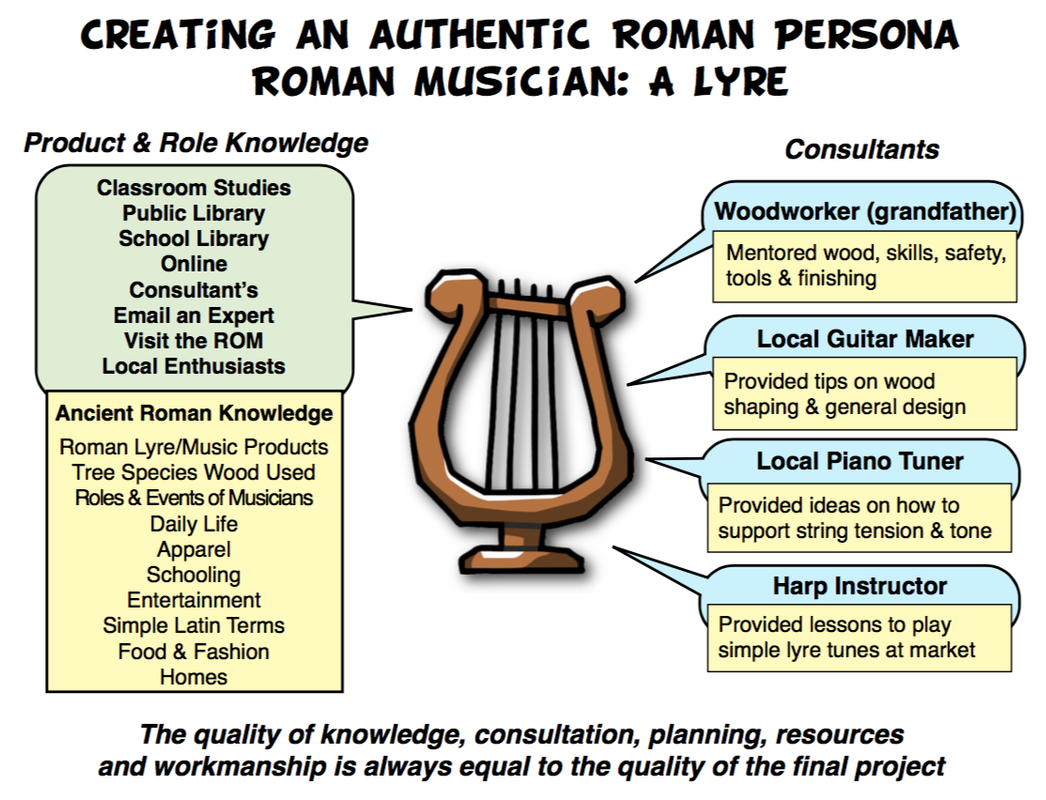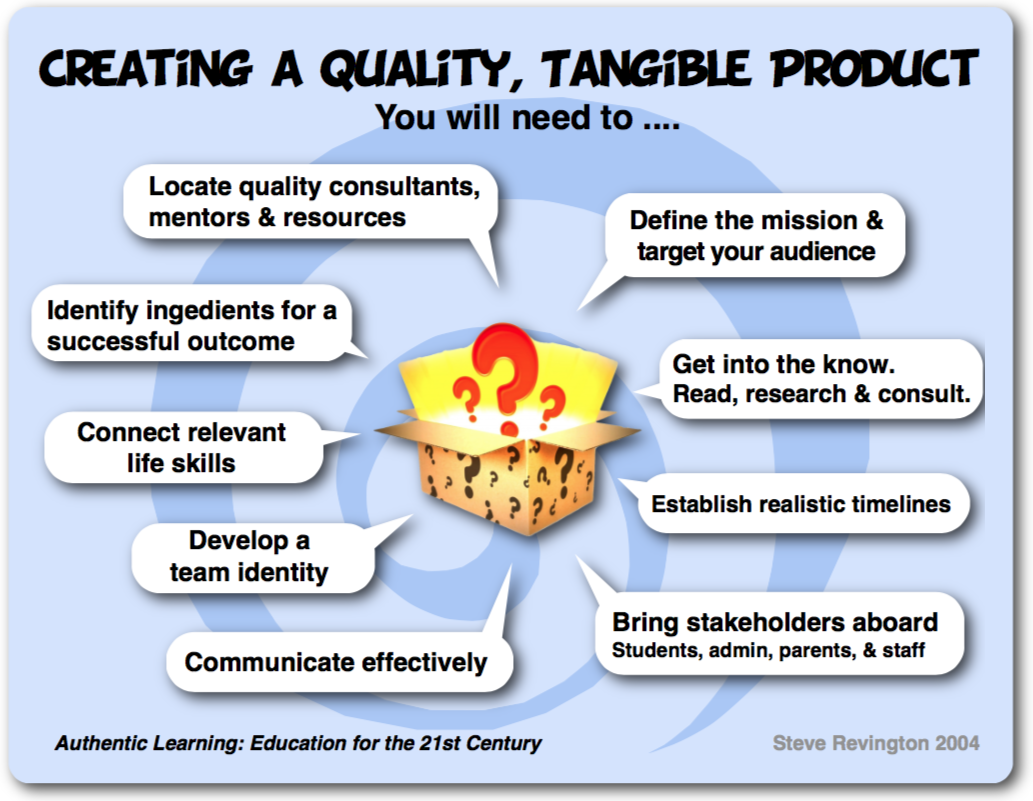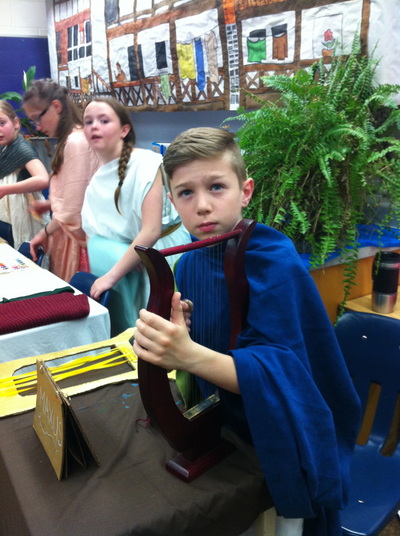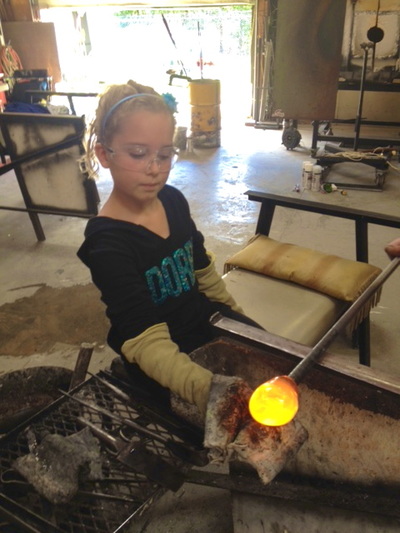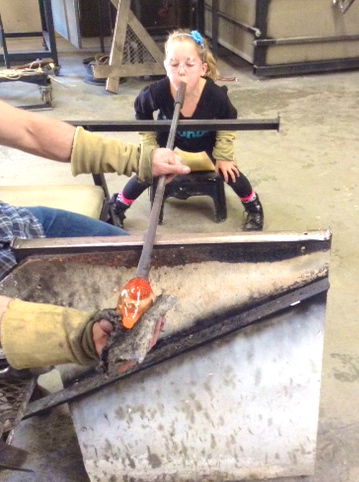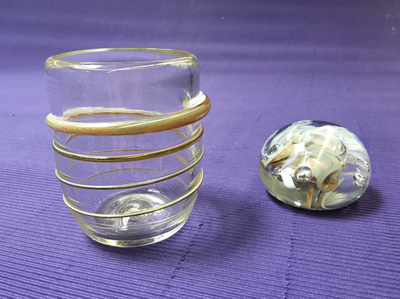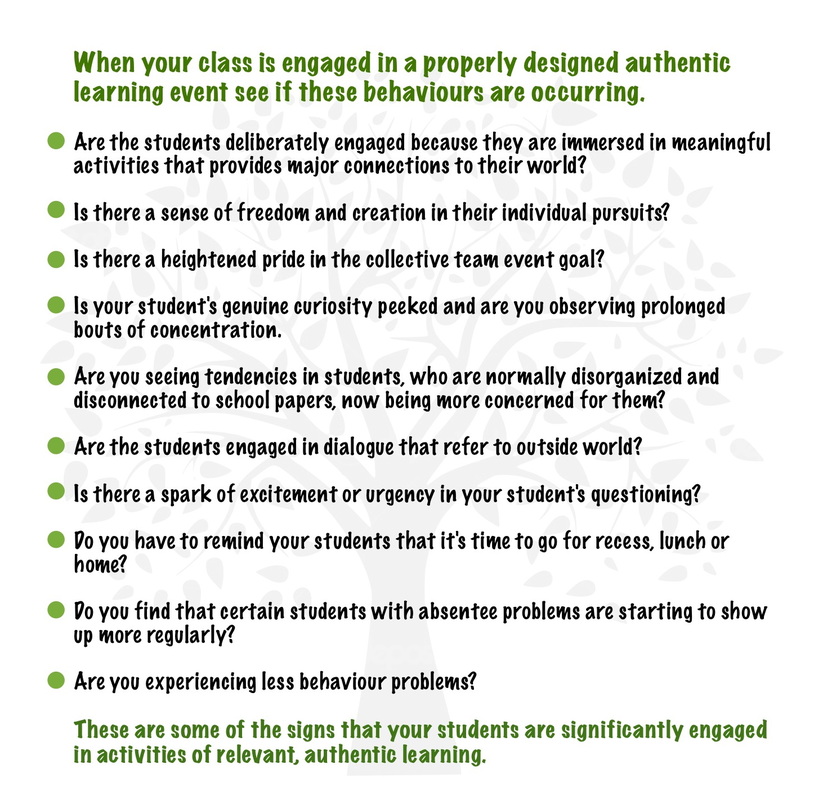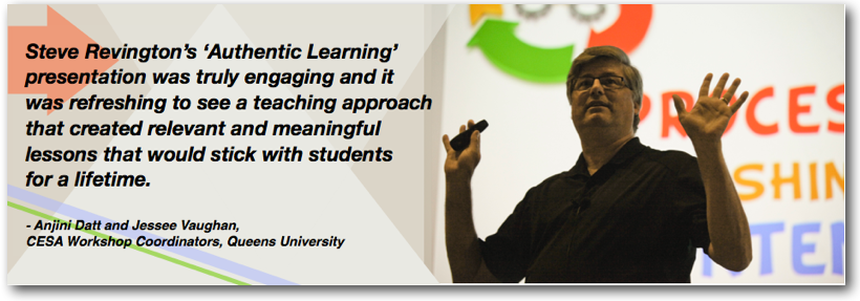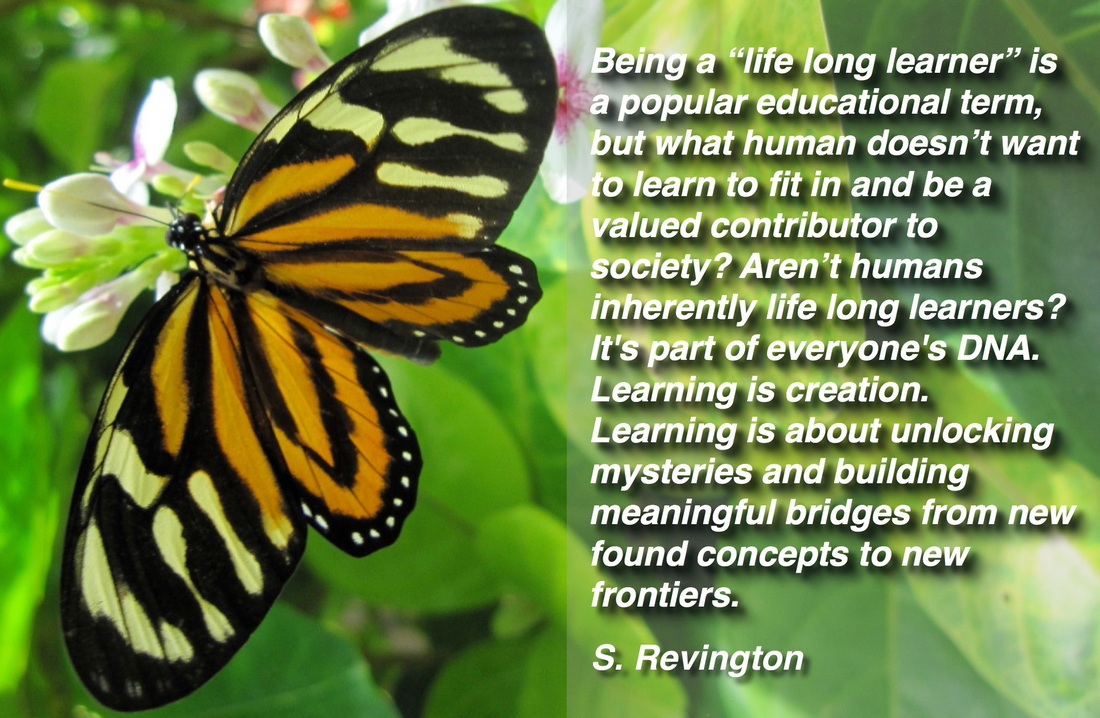Defining Authentic Learning by Steve Revington
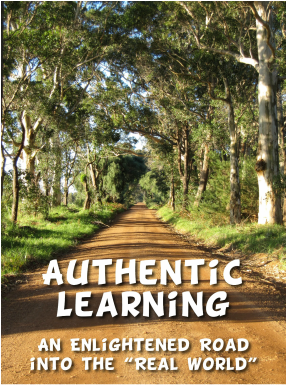
Authentic learning is real life learning. It is a style of learning that encourages students to create a tangible, useful, quality product/outcome to be shared with their world. Once an educator provides a motivational challenge, or student selects their initiative, it is imperative to nurture and support the necessary criteria, planning, timelines, resources and support to accommodate student success. The teacher becomes a guide on the side or an event manager, a facilitator that co-creates with their students. Processes become the predominant forces while skills, knowledge and behaviours are activated in real-world, relevant contexts.
Authentic learning is actualized learning. It is only when student initiatives are directed towards a genuine audience, beyond the classroom, that learning becomes truly activated. When learning initiatives are designed for initiatives that permeate the classroom walls, then lasting, transferrable learning begins to take hold. It can be achieved by going out to the community, by inviting a community audience into the school setting, or directing it towards an audience in the global, digital or electronic domain.
When relevant and meaningful learning initiatives are skilfully designed and implemented for a genuine audience, in a realistic context, then innate neurological receptors to learn are heightened. The closer learning is to real-life scenarios, the more optimal the learning experience will be.
Authentic learning engages all the senses allowing students to create a meaningful, useful, shared outcome. They are real life tasks, or simulated tasks, that provide the learner with opportunities to connect directly with a relevant world.
Instead of vicariously discussing topics and regurgitating information in a traditional industrial age modality, authentic learning provides a learner with support to achieve a tangible, useful, quality product worth sharing with an audience in their world. Instead of prioritizing the curriculum expectations and its contents over experience rich processes, authentic learning chooses fertile, student driven, community connected audiences to create experience rich products for and then strategically align relevant curricula connections to them.
As Albert Einstein stated, "The only source of knowledge is the experience." Yes we are complex, intricately wired beings with a vast network of neuro-receptors that serve us on our unique journeys through life. Regardless of our analytical talents, physical prowess, perceptual abilities or health status, we all come with plethora of innate skills and deficits. It's only when we're exposed to opportunities to explore, engage, create, reflect, interact socially, emotionally and cognitively with our environment that creates experience
exposure to Authentic learning emphasizes 'experience nurturing' that provides longer lasting, transferable skills to an individual. It is more relevant, motivational and personal.
Our greatest short coming in education these past years has been to ignore the brain research that is richly available to us that affirms that implementing multi-sensory activities, pursuing meaningful tasks, exploring a variety of skills with real world applications is optimal learning and that it needs to be practiced regularly.
A student sitting at a desk, taking notes and regurgitating curriculum content uses a minute amount of their potential. In general, students learn to sit quietly, respond in turn, follow instructions and complete tests for a control teacher. Without relevance, personal connection, multi-sensory engagement and purpose, content driven curricula begins to evaporate once the test has been taken. You remember studying for exams, cramming, finding memory cues and rote to consolidate information? Do you also remember how fast you started to forget those brain bytes once you left the exam room? If it's not relevant to you, it not lasting, transferrable learning. If learning is not based in the rich processes that only experiences can provide, it's static learning.
“The only source of knowledge is the experience.”
- Albert Einstein
This classic, industrial age approach has been used since the mid 1870's to produce a work force to facilitate mass production lines that were to become prevalent in the next hundred years. That era ended in the 1980's if not before. If all we do is sit at a square table, with a square piece of paper, in a square room with departmentalized lessons and timetables, then what are our education systems really producing? Brain-based research shows that by using all senses it maximizes the learning experience. The key being - the experience!
Interacting, manipulating, exploring, collaborating, discussing openly and sharing for meaningful reasons while having ample time to nurture a greater depth of reasoning and creativity is optimal learning. It's learning that sticks. It's learning with roots!
Authentic learning is actualized learning. It is only when student initiatives are directed towards a genuine audience, beyond the classroom, that learning becomes truly activated. When learning initiatives are designed for initiatives that permeate the classroom walls, then lasting, transferrable learning begins to take hold. It can be achieved by going out to the community, by inviting a community audience into the school setting, or directing it towards an audience in the global, digital or electronic domain.
When relevant and meaningful learning initiatives are skilfully designed and implemented for a genuine audience, in a realistic context, then innate neurological receptors to learn are heightened. The closer learning is to real-life scenarios, the more optimal the learning experience will be.
Authentic learning engages all the senses allowing students to create a meaningful, useful, shared outcome. They are real life tasks, or simulated tasks, that provide the learner with opportunities to connect directly with a relevant world.
Instead of vicariously discussing topics and regurgitating information in a traditional industrial age modality, authentic learning provides a learner with support to achieve a tangible, useful, quality product worth sharing with an audience in their world. Instead of prioritizing the curriculum expectations and its contents over experience rich processes, authentic learning chooses fertile, student driven, community connected audiences to create experience rich products for and then strategically align relevant curricula connections to them.
As Albert Einstein stated, "The only source of knowledge is the experience." Yes we are complex, intricately wired beings with a vast network of neuro-receptors that serve us on our unique journeys through life. Regardless of our analytical talents, physical prowess, perceptual abilities or health status, we all come with plethora of innate skills and deficits. It's only when we're exposed to opportunities to explore, engage, create, reflect, interact socially, emotionally and cognitively with our environment that creates experience
exposure to Authentic learning emphasizes 'experience nurturing' that provides longer lasting, transferable skills to an individual. It is more relevant, motivational and personal.
Our greatest short coming in education these past years has been to ignore the brain research that is richly available to us that affirms that implementing multi-sensory activities, pursuing meaningful tasks, exploring a variety of skills with real world applications is optimal learning and that it needs to be practiced regularly.
A student sitting at a desk, taking notes and regurgitating curriculum content uses a minute amount of their potential. In general, students learn to sit quietly, respond in turn, follow instructions and complete tests for a control teacher. Without relevance, personal connection, multi-sensory engagement and purpose, content driven curricula begins to evaporate once the test has been taken. You remember studying for exams, cramming, finding memory cues and rote to consolidate information? Do you also remember how fast you started to forget those brain bytes once you left the exam room? If it's not relevant to you, it not lasting, transferrable learning. If learning is not based in the rich processes that only experiences can provide, it's static learning.
“The only source of knowledge is the experience.”
- Albert Einstein
This classic, industrial age approach has been used since the mid 1870's to produce a work force to facilitate mass production lines that were to become prevalent in the next hundred years. That era ended in the 1980's if not before. If all we do is sit at a square table, with a square piece of paper, in a square room with departmentalized lessons and timetables, then what are our education systems really producing? Brain-based research shows that by using all senses it maximizes the learning experience. The key being - the experience!
Interacting, manipulating, exploring, collaborating, discussing openly and sharing for meaningful reasons while having ample time to nurture a greater depth of reasoning and creativity is optimal learning. It's learning that sticks. It's learning with roots!
Process and Content: Let's re-prioritize the learning journey
In an authentic learning model the emphasis is to prioritize the processes over the content. It's about allowing students to pursue individual learning opportunities that are unique to their interests, through relevant, real life journeys. The emphasis isn't just about regurgitating content for a unit test, it's about developing a set of culminating skills sets, within a realistic timeline, using self-motivated, natural inquiry methods to create a useful product to be shared with a specific, meaningful audience. It's about engaging students into full fledged, multi-sensory contexts that nurture their learning experiences in significant, lasting ways.
More importantly, the learning journey that ensues is life altering as students are aligned to meaningful processes that nurture non-perishable skills rather than the short term memory exercises that a content driven curriculum demands. Don't get me wrong, content is important but when using an authentic learning approach content is recognized as it is properly intended to be - a portfolio of records, research, plans, lists, notes, reading, contacts, drafts and support information that will become the artifacts of the authentic journey.
With the advent of the internet, content is readily available to everyone. We can reference, cross reference, research any topic at rapid speeds and do it at any time when it's relevant for us. We can access it through mobiles, tablets or computers as we access information as it is needed and when it is needed. Is it still relevant for a teacher to predominately dispense content to students, then evaluate the regurgitation of that content given as the main assessment of a person's learning ability?
Authentic learning allows for students to demonstrate their skills through a series of unfolding learning processes with a definitive, quality product that they can actually demonstrate. At no time in history has information (content) been so readily available to the masses, but it's the synergy and processes of engagement that defines our human experience. That's where the real value in education lies. Students need purpose. They need to feel useful and be a valued part of a community. They need to feel connected and real-world contexts allow for these elements to be activated and groomed. By nurturing 'purpose' we are providing the channels for students to recognize their unique talents and see their inherent value in society. Thus, individual and community self-esteem becomes a priceless byproduct of a successful authentic learning initiative.
More importantly, the learning journey that ensues is life altering as students are aligned to meaningful processes that nurture non-perishable skills rather than the short term memory exercises that a content driven curriculum demands. Don't get me wrong, content is important but when using an authentic learning approach content is recognized as it is properly intended to be - a portfolio of records, research, plans, lists, notes, reading, contacts, drafts and support information that will become the artifacts of the authentic journey.
With the advent of the internet, content is readily available to everyone. We can reference, cross reference, research any topic at rapid speeds and do it at any time when it's relevant for us. We can access it through mobiles, tablets or computers as we access information as it is needed and when it is needed. Is it still relevant for a teacher to predominately dispense content to students, then evaluate the regurgitation of that content given as the main assessment of a person's learning ability?
Authentic learning allows for students to demonstrate their skills through a series of unfolding learning processes with a definitive, quality product that they can actually demonstrate. At no time in history has information (content) been so readily available to the masses, but it's the synergy and processes of engagement that defines our human experience. That's where the real value in education lies. Students need purpose. They need to feel useful and be a valued part of a community. They need to feel connected and real-world contexts allow for these elements to be activated and groomed. By nurturing 'purpose' we are providing the channels for students to recognize their unique talents and see their inherent value in society. Thus, individual and community self-esteem becomes a priceless byproduct of a successful authentic learning initiative.
I believe that education systems must reevaluate the weighting of its' curricula as it must reflect a working balance between learning processes and properly aligned content? Remember, processes take time to learn but once they're consolidated they're impact lasts for a long time. Processes require skill sets that are developmentally prioritized and require skilled instructors to transfer these skills. If you want students to engage in deeper thinking opportunities, then time is one of the most valued commodities. Are education systems willing to forgo the number of content expectations in their curricula in favour of embracing processes that require more time commitment?
With the recognition of STEM, STEAM, Maker education platforms in the past decade, it demonstrates a deeper appreciation and commitment to relevant processes. This is very promising!
Good teachers are quick to point out that their curricula covers so many topics and expectations that there isn't enough time to cover everything appropriately. The more topics, the more content and the more time it takes to cover everything in the curriculum, and mathematically it just doesn't work. The rules dictate how the game is played, so to cover every expectation educational systems rely on the "here's the information" and "here's the test" mode of education. It's an efficient way to deliver content quickly so that all expectations are lawfully covered. It's an over used exercise in short term memory skills and cognitive cueing tricks, but its not a fulfilling, meaningful way to learn. Unless students are immersed in relevant, multi-sensory activities with specific, audience directed outcomes and culminating skills sets, then what students are learning is not sticking.
The quality of research, subject knowledge, skill development, expert consultation, dedication and resourcefulness that goes into making a product is directly related to the quality outcome of that product.
With the recognition of STEM, STEAM, Maker education platforms in the past decade, it demonstrates a deeper appreciation and commitment to relevant processes. This is very promising!
Good teachers are quick to point out that their curricula covers so many topics and expectations that there isn't enough time to cover everything appropriately. The more topics, the more content and the more time it takes to cover everything in the curriculum, and mathematically it just doesn't work. The rules dictate how the game is played, so to cover every expectation educational systems rely on the "here's the information" and "here's the test" mode of education. It's an efficient way to deliver content quickly so that all expectations are lawfully covered. It's an over used exercise in short term memory skills and cognitive cueing tricks, but its not a fulfilling, meaningful way to learn. Unless students are immersed in relevant, multi-sensory activities with specific, audience directed outcomes and culminating skills sets, then what students are learning is not sticking.
The quality of research, subject knowledge, skill development, expert consultation, dedication and resourcefulness that goes into making a product is directly related to the quality outcome of that product.
Is It Authentic Learning or Not?
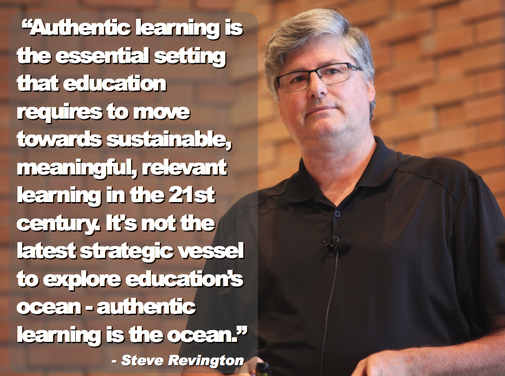
Remember, in true authentic learning an outcome designed to interact successfully with a community is the goal. When this happens a whole new layer of emotional, academic and skill set developments take place. There's a big difference between preparing a skit for some classmates verses a dramatic production for the public. There's a much larger personal investment required when a student becomes an ancient Egyptian tradesperson producing tools and wares, while working at a market stall to an interacting audience than holding up a Bristol board display and explaining ancient Egyptian information on it. Best of all, the student retains information from this type of multi-sensory, authentic learning experience longer because it's real, it's connected.
Authentic learning is not project-based learning nor is it constructivism. These models of education were designed within the classroom context. Although at times they stepped successfully into the world of authentic, and are extremely useful tools in moving closer to an authentic learning approach they are not authentic learning models. Authentic learning is intended to successfully interact with a community; by going out to interact with a community or the community coming into the student community to interact. That's why it's authentic! It's a quality outcome or product of significance that is intended for community consumption or betterment.
Kudos to those teachers who provide project-based, simulation, game-based learning opportunities, Maker, STEM and STEAM. These are significant, engaging initiatives that provide the best kind of classroom learning and education systems need more of you. They are fantastic opportunities in providing working instruction and to model inquiry method, team work and sound skill development. What I'm encouraging is to take the next step. Consider a project to be developed for real world applications beyond the school walls, for a viable audience. Not every time, but perhaps once in a school year attempt an authentic event. For those who have stepped into the realm of authentic you'll understand how this impacts everything. It will impact the initial discussions, the consultation, the refined skill sets, networking and the professional development a student and teacher requires.
Authentic learning is not project-based learning nor is it constructivism. These models of education were designed within the classroom context. Although at times they stepped successfully into the world of authentic, and are extremely useful tools in moving closer to an authentic learning approach they are not authentic learning models. Authentic learning is intended to successfully interact with a community; by going out to interact with a community or the community coming into the student community to interact. That's why it's authentic! It's a quality outcome or product of significance that is intended for community consumption or betterment.
Kudos to those teachers who provide project-based, simulation, game-based learning opportunities, Maker, STEM and STEAM. These are significant, engaging initiatives that provide the best kind of classroom learning and education systems need more of you. They are fantastic opportunities in providing working instruction and to model inquiry method, team work and sound skill development. What I'm encouraging is to take the next step. Consider a project to be developed for real world applications beyond the school walls, for a viable audience. Not every time, but perhaps once in a school year attempt an authentic event. For those who have stepped into the realm of authentic you'll understand how this impacts everything. It will impact the initial discussions, the consultation, the refined skill sets, networking and the professional development a student and teacher requires.
Think about it. Every important, relevant thing a person requires to achieve a goal in life has a quality outcome or product attached to it with an intended audience. Pitching a business proposal requires an in depth presentation that reflects relevance, meaning and purpose. If it's backed by tangible proof, even better. A prototype of a new invention requires a quality, tested, working device or apparatus to gain support in the marketing world. An environmental assessment requires extensive research and impact studies of connected, like-situations from around the ecological world.
A grade five teacher once shared a wonderful collection of student written and recorded persuasive "Saving Energy" stories with me. They even designed CD covers in art lessons for their project. The work, learning and planning by teacher and student was tremendous. Upon being asked however, "What did you do with all that great work" she replied she'd listened to the CD in class and put the CD covers up on the bulletin board. This is a great example of integrated learning but it's not authentic learning.
By planning beyond the classroom, a whole new level of understanding and relevant learning takes place. What if the CDs were intended for sale at the nearest mall? Now, an in depth degree of consultation needs to be pursued. Mall managers, local radio stations, graphic designers, bar codes for selling, copyrights local recording studios and marketing experts will need to be considered. That's the major leap an educator needs to take to enter the realm of authentic learning. What if the recordings were uploaded onto a website and promoted to leaders of energy conservation intended to be used to educate the surrounding community on "Energy Saving"? What about an "Energy Saving in Our Homes" campaign within your community? These are only suggestions but with a little brainstorming and with the right people, it wouldn't be long until a list of exciting possibilities could be created. Why are they exciting possibilities? Because they're real, relevant and worthy!
A grade five teacher once shared a wonderful collection of student written and recorded persuasive "Saving Energy" stories with me. They even designed CD covers in art lessons for their project. The work, learning and planning by teacher and student was tremendous. Upon being asked however, "What did you do with all that great work" she replied she'd listened to the CD in class and put the CD covers up on the bulletin board. This is a great example of integrated learning but it's not authentic learning.
By planning beyond the classroom, a whole new level of understanding and relevant learning takes place. What if the CDs were intended for sale at the nearest mall? Now, an in depth degree of consultation needs to be pursued. Mall managers, local radio stations, graphic designers, bar codes for selling, copyrights local recording studios and marketing experts will need to be considered. That's the major leap an educator needs to take to enter the realm of authentic learning. What if the recordings were uploaded onto a website and promoted to leaders of energy conservation intended to be used to educate the surrounding community on "Energy Saving"? What about an "Energy Saving in Our Homes" campaign within your community? These are only suggestions but with a little brainstorming and with the right people, it wouldn't be long until a list of exciting possibilities could be created. Why are they exciting possibilities? Because they're real, relevant and worthy!
One of the reasons I started to use the term "authentic learning" was that I recognized that the term "outcomes-based" education, William Spady's model which shared a number of characteristics, was being recognized mainly for it's outcome statements. His strategy of reforming an education system, built on students performing a hierarchy of skills was diluted down to the content-based, outcome statements. Again, it became more about the content than pursuing the meaningful journey of authentic education. It isn't hard to understand why this happened because that's how it would be perceived by policy makers who's successes were affirmed in a content driven system.
Authentic learning is not another edu-trend or buzz word. It is real life - real world education and when appropriately implemented it can provide optimal learning opportunities to all students. I have noticed that some educators are misrepresenting the term "authentic" to qualify their student's inferred learning. If learning is engaged solely in classroom settings, referencing real world examples only, it's vicarious learning, - it's not authentic learning. Authentic learning is relevant learning, activated in a real world context to a real world audience.
If you've ever initiated a business or an organization, you'll have a far better understanding of the enormous work and planning an authentic learning event requires. As in real life - these initiatives take an enormous amount of time, dedication, consulting, flexibility, networking, research and communication to launch. Yes, to launch! Once the launch has been initiated, then the real work starts. As guide on the side, or project manager you're now having to coordinate, educate, coach, consult and communicate with your students and parents in shaping their successful roles while pursuing the larger goal of your signature event. As well, you're going to require some additional professional development directly connected to the skills required in your authentic initiative.
Creating a Signature Event
A signature event is when tangible product is shared with a genuine, relevant audience. For example; if your high school senior class planned to design, construct and test their solar cars, organizing a Solar Car Derby with a spectator audience at a nearby racetrack would be a worthwhile signature event.
To fully immerse the students in an authentic learning experience they would be expected to prepare for the event with community experts, consultants, parents, teacher colleagues and community leaders. The more the students participate in the organization of the event, the more ownership and pride the students will have towards the event.
By providing students with the opportunity to have input at all levels allows for the distribution of learning at all levels. If there are rules involved, then student representatives need to be part of the derby rules development, refinement and approval. Students will possess a better grasp of all aspects of the authentic event when they are personally connected to the complete journey.
While the signature event is being planned, the students are honing their knowledge and skills to create their own quality product to share. It all depends on the type of product being created that will dictate how much class time can be used to design and create their products.
This style of learning is labour intensive and time consuming but it is the most worthwhile education you can provide students. Once you've implemented an authentic event, or simulation, the impact on student development is remarkable. The great thing about authentic learning is, it's a context that allows for student's uniqueness to be highlighted. Whether it's a specific skill, academic or a social/behaviour issue, an authentic setting, appropriately implemented, provides a very rich personal growth setting.
This new, authentic learning approach, however, requires another breed of educator. An academic as well as a life skilled, co-creator. A real, "life" long learner with skill sets and experiences that can facilitate a creative, diverse, well structured, team-based, open-ended, criteria based and globally directed education program. Ask yourself if you're on the way down the enlightened authentic learning road? Are you working towards sharing a tangible product beyond the class or bringing the world into your schools either electronically or for real? The authentic experiences you provide your students is also the beginning of an unforgettable learning journey in your life.
Authentic learning is not another edu-trend or buzz word. It is real life - real world education and when appropriately implemented it can provide optimal learning opportunities to all students. I have noticed that some educators are misrepresenting the term "authentic" to qualify their student's inferred learning. If learning is engaged solely in classroom settings, referencing real world examples only, it's vicarious learning, - it's not authentic learning. Authentic learning is relevant learning, activated in a real world context to a real world audience.
If you've ever initiated a business or an organization, you'll have a far better understanding of the enormous work and planning an authentic learning event requires. As in real life - these initiatives take an enormous amount of time, dedication, consulting, flexibility, networking, research and communication to launch. Yes, to launch! Once the launch has been initiated, then the real work starts. As guide on the side, or project manager you're now having to coordinate, educate, coach, consult and communicate with your students and parents in shaping their successful roles while pursuing the larger goal of your signature event. As well, you're going to require some additional professional development directly connected to the skills required in your authentic initiative.
Creating a Signature Event
A signature event is when tangible product is shared with a genuine, relevant audience. For example; if your high school senior class planned to design, construct and test their solar cars, organizing a Solar Car Derby with a spectator audience at a nearby racetrack would be a worthwhile signature event.
To fully immerse the students in an authentic learning experience they would be expected to prepare for the event with community experts, consultants, parents, teacher colleagues and community leaders. The more the students participate in the organization of the event, the more ownership and pride the students will have towards the event.
By providing students with the opportunity to have input at all levels allows for the distribution of learning at all levels. If there are rules involved, then student representatives need to be part of the derby rules development, refinement and approval. Students will possess a better grasp of all aspects of the authentic event when they are personally connected to the complete journey.
While the signature event is being planned, the students are honing their knowledge and skills to create their own quality product to share. It all depends on the type of product being created that will dictate how much class time can be used to design and create their products.
This style of learning is labour intensive and time consuming but it is the most worthwhile education you can provide students. Once you've implemented an authentic event, or simulation, the impact on student development is remarkable. The great thing about authentic learning is, it's a context that allows for student's uniqueness to be highlighted. Whether it's a specific skill, academic or a social/behaviour issue, an authentic setting, appropriately implemented, provides a very rich personal growth setting.
This new, authentic learning approach, however, requires another breed of educator. An academic as well as a life skilled, co-creator. A real, "life" long learner with skill sets and experiences that can facilitate a creative, diverse, well structured, team-based, open-ended, criteria based and globally directed education program. Ask yourself if you're on the way down the enlightened authentic learning road? Are you working towards sharing a tangible product beyond the class or bringing the world into your schools either electronically or for real? The authentic experiences you provide your students is also the beginning of an unforgettable learning journey in your life.
The Tale of Two Lyres
Pictures of Quality Products (below)
It's All in the "Doing"
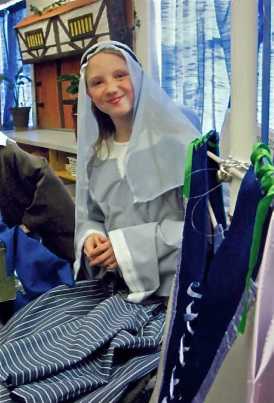
Talia is a medieval tailor at an authentic learning event.
I had just completed an authentic event, a Medieval Market Living Museum one April evening. It was the culmination of one and half months of preparation as the students demonstrated their personas (roles) as medieval trades people in medieval Coventry, UK. The students worked diligently away at their trades during this open house, all academic levels to their potential. Their goal was to create an authentic medieval trade persona, an authentic costume that reflected their trade role, an authentic working trade tool or product and a market stall to share their wares. The room was decorated with beautiful tapestries, murals, personalized heraldry banners and a large book display of the student's collective work/activity sheets carefully spiral bound.
In authentic learning paper collections are referred to as portfolios. These portfolios were carefully done and included an extensive variety of curriculum content and authentic learning preparation sheets. Spelling, creative writing, math, art, drama, technology, problem solving and reading comprehension work sheets were all included. Nearly five hundred visitors came through our themed room and only about ten people even looked through the spiraled bound unit booklets. They were clearly displayed, beautifully presented and featured eye pleasing, colorful covers.
Visitors were far more interested in interacting with the trades people, hearing their stories, watching them work, than reading the notes that helped them attain their goal. Really, it is this kind of instance that affirms the reality that content and paper curriculum isn't as important as we believe them to be. It's important, and it certainly has its place, but the applied knowledge is far more important. The doing consolidates all the learning that went into the event.
Somewhere along the continuum of learning development the jot notes became more important than the tangible, meaningful applications of the education purpose itself. In the end, it's the applied demonstration that counts. "It's all in the doing".
In authentic learning paper collections are referred to as portfolios. These portfolios were carefully done and included an extensive variety of curriculum content and authentic learning preparation sheets. Spelling, creative writing, math, art, drama, technology, problem solving and reading comprehension work sheets were all included. Nearly five hundred visitors came through our themed room and only about ten people even looked through the spiraled bound unit booklets. They were clearly displayed, beautifully presented and featured eye pleasing, colorful covers.
Visitors were far more interested in interacting with the trades people, hearing their stories, watching them work, than reading the notes that helped them attain their goal. Really, it is this kind of instance that affirms the reality that content and paper curriculum isn't as important as we believe them to be. It's important, and it certainly has its place, but the applied knowledge is far more important. The doing consolidates all the learning that went into the event.
Somewhere along the continuum of learning development the jot notes became more important than the tangible, meaningful applications of the education purpose itself. In the end, it's the applied demonstration that counts. "It's all in the doing".
Student Behaviours When Immersed in Authentic Learning
So Where Do We Start?
Is it realistic to think that authentic learning of this nature can be done, ongoing, throughout the school year? Of course it can and there are school's that engage in authentic approaches already. Maybe one day authentic learning may be the motis operandum of the majority of schools, but realistically not yet. With the current school classroom structures, resources, timetabling, standardized test demands, physical classroom limitations, administration directives and the plethora of curriculum expectations as they are, it's difficult to do.
If, however, an educator can attempt one or two authentic learning events in a school year then that's a fantastic start. At year's end you and your students won't regret it and it won't be long until you're looking forward to starting your next. There are different degrees of authentic learning events from simulations shared with your community to complete, real world integrations. Start small, then develop your authentic learning undertakings over the years to come. Let other educators, parents and community members observe your authentic learning events. Remember, a well implemented authentic unit/event is the best kind of promotion for this rich style of learning.
If, however, an educator can attempt one or two authentic learning events in a school year then that's a fantastic start. At year's end you and your students won't regret it and it won't be long until you're looking forward to starting your next. There are different degrees of authentic learning events from simulations shared with your community to complete, real world integrations. Start small, then develop your authentic learning undertakings over the years to come. Let other educators, parents and community members observe your authentic learning events. Remember, a well implemented authentic unit/event is the best kind of promotion for this rich style of learning.

